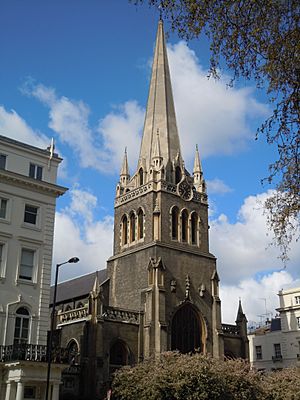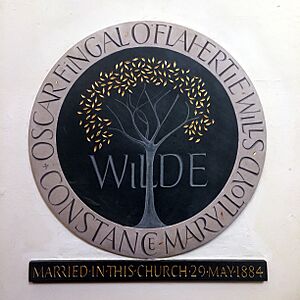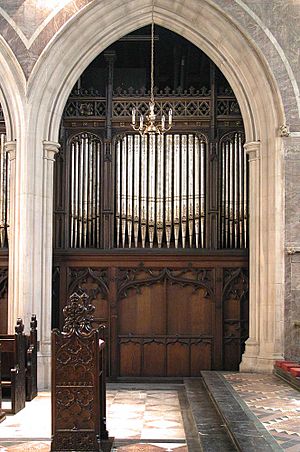St James's Church, Paddington facts for kids
Quick facts for kids St James’ Church, Paddington |
|
|---|---|

St James’ Church, Sussex Gardens, Paddington
|
|
| 51°30′46.8″N 0°10′35.4″W / 51.513000°N 0.176500°W | |
| Location | Paddington |
| Country | England |
| Denomination | Church of England |
| Churchmanship | Anglo-Catholic |
| History | |
| Dedication | St James the Less |
| Architecture | |
| Heritage designation | Grade II* listed |
| Architect(s) | George Edmund Street |
| Groundbreaking | 1841 and 11 February 1882 |
| Completed | 1882 |
| Administration | |
| Parish | St James Paddington |
| Deanery | Westminster Paddington |
| Archdeaconry | Charing Cross |
| Diocese | London |
| Province | Canterbury |
St James' Church Paddington, also known as St James' Church Sussex Gardens, is a Church of England parish church in Paddington, London, in the United Kingdom. It is the main church for the area of Paddington. You can find it at the western end of Sussex Gardens, a long street with trees. It's about 175 meters north of Hyde Park.
Contents
History of St James' Church
Building the First Church
Before the 1840s, the main church in Paddington was St Mary's Paddington Green. However, it became too small for all the people who wanted to attend. So, between 1841 and 1843, a new church called St James's was built. This new church was meant to hold more worshippers and take over as the main parish church.
The first design for St James's Church was by John Goldicutt. He planned a neo-classical style, which was inspired by his travels in Italy. He wanted it to be built with yellow bricks. After Goldicutt passed away, George Gutch finished the church. He kept the yellow bricks but changed the style to Gothic.
Rebuilding and Expansion
About 40 years later, the church was again too small for its growing community. A famous Gothic Revival architect named G. E. Street planned a big rebuilding project. He decided to keep some parts of the original church but redesign it in a 14th-century Gothic style.
Interestingly, Street changed the usual direction of the church. Most churches have their main altar (chancel) facing east, but he planned for St James's chancel to face west. Sadly, G. E. Street died in December 1881 before the building work began. Two months after his death, on February 11, 1882, Princess Christian of Schleswig-Holstein laid the foundation stone for the new church. The building work was then completed by Sir Arthur Blomfield, who worked with G. E. Street's son, A. E. Street.
Famous Wedding at St James'
On May 29, 1884, the famous Irish writer Oscar Wilde married Constance Lloyd at St James's Church. This special event is remembered with a round plaque on the wall at the east end of the church. The plaque is made of Welsh slate and was designed by Tom Sargeant. It was put up on May 29, 2016, to celebrate the 132nd anniversary of their wedding.
World War II and Renovations
In 1940, during World War II, St James's Church was badly damaged during the Blitz. The church's crypt (an underground room) was used as an air-raid shelter to protect people.
After the war, the damage was repaired. The church was reopened in July 1958 by Princess Marina, Duchess of Kent. During these renovations, new stained glass windows were added by A. E. Buss of Goddard & Gibbs.
One of these windows, called the Te Deum window, is at the east end. It shows important historical figures who lived in the St James' parish. These include Alexander Fleming, who discovered penicillin; J. M. Barrie, who wrote Peter Pan; and Lord Baden-Powell, who started the Scout Association. The window also shows a scene from the Blitz, remembering those who died during the Battle of Britain.
The Church Organ
The organ at St James' Church was built in 1882 by William Hill & Sons. This amazing musical instrument has been rebuilt and updated several times over the years.
Organ History and Features
Originally, the organ had three manuals (keyboards). In 1908, a fourth manual, called the Solo, was added when Hele & Co of Plymouth made the organ bigger. It was then rebuilt again in 1936 by Rushworth and Dreaper of Liverpool, and once more in 1972 by J. W. Walker & Sons Ltd. You can find more details about the organ on the National Pipe Organ Register.
Organists of St James'
- 1894-1907: Henry J. B. Dart
- 1911-1916: Harold Darke
- ?-?: George Thalben-Ball
- 2015-present: George de Voil



